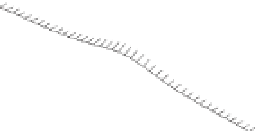Geoscience Reference
In-Depth Information
equal to 10 gu). We use gu throughout our description of the
gravity method. Rates of spatial change in gravity, i.e. grav-
ity gradients, are de
ned in terms of a unit known as the
Eötvös (Eo), which is a gradient of 10
-
6
mgal/cm, equal to
1 gu/km, 10
-
3
gu/m, 10
-
9
ms
-2
m
-1
or 1 ns
-2
.
a)
X
X'
3.2.1.3
Excess mass
A buried body with higher density than the surrounding
country rocks, i.e. a positive density contrast (
X
), pro-
duces an increase in mass above that which would be
present if the body had the same density as the country
rock. This extra mass is known as excess mass (M
e
) and
is given by:
Δρ
b)
D
X'
Source
M
e
¼ Δρ
V
¼ðρ
body
ρ
country
Þ
V
ð
3
:
5
Þ
c)
Depth
where V is the volume of the body, and
ρ
body
and
ρ
country
Gravity
are the densities of
the body and the country rock,
respectively.
It is the excess mass that gives rise to a positive gravity
anomaly (see
Section 3.2.2
). When the body has lower
density than the country rock, i.e. a negative density
contrast, it exhibits a mass de
ciency and produces a nega-
tive gravity anomaly, cf.
Fig. 2.4
. Note that it is the excess
mass (or mass de
ciency as the case may be) that gives rise
to the gravity anomaly and not the body
Gravity
anomaly
Earth's field
A
B
C
D
E
F
G
X
X
d)
Vertical component of
source's field at surface
X
X
s absolute mass.
Excess mass may be estimated from modelling (see
determined as follows:
'
A
B
C
D
E
F
G
Earth's field
Source
¼
ρ
body
Δρ
ρ
body
ρ
body
ρ
country
M
e
Depth
Source's field
M
a
M
e
¼
ð
3
:
6
Þ
Figure 3.3
Gravitational
field of a sphere. (a) Gravity measured on a
horizontal surface above a dense spherical source (b). (c) Variation
in the vertical component of gravity along the principal pro
le
3.2.2
Gravity anomalies
X
0
) due to the combined effects of the Earth
(X
-
'
s
field and that of the
sphere. (d) The radially directed gravity
field of the source and its
vertical component. Note that the strength of the Earth
Figure 3.3
shows the effect on the gravity field of a spherical
source in the subsurface that is denser than its surrounds. For
the simple model shown, gravity measurements are made on
a horizontal surface above the source, and the gravitational
attraction due to the Earth is taken as constant over the area
'
s gravity
field is many times greater than that of the source, but has been
reduced here for clarity.
sphere add to form the resultant total gravity
field. The
gravity instrument is aligned in the direction of the total
field
ity anomaly (change in gravity) is simply the magnitude of
the variation in the total
field, which is the vertical compon-
that because a gravity source is a monopole, its gravity anom-
aly has single polarity (sign) and has its peak centred directly
above the source. This simple model illustrates how a high-
density body in the subsurface, such as a mineral deposit, can
s
field
is radially directed towards its centre of mass. The Earth
'
s
field is radially directed toward the centre of the Earth, but the
Earth is so large that the
field lines are effectively parallel in
the area depicted by the
figure. In the presence of an excess
mass, the
field lines de
ect towards the anomalous mass; but
the effect is negligible because the strength of the Earth
'
'
s
gravity
field is substantially larger than that of any excess
mass in the crust. The gravity fields of the Earth and the






















































































































































































































Search WWH ::

Custom Search